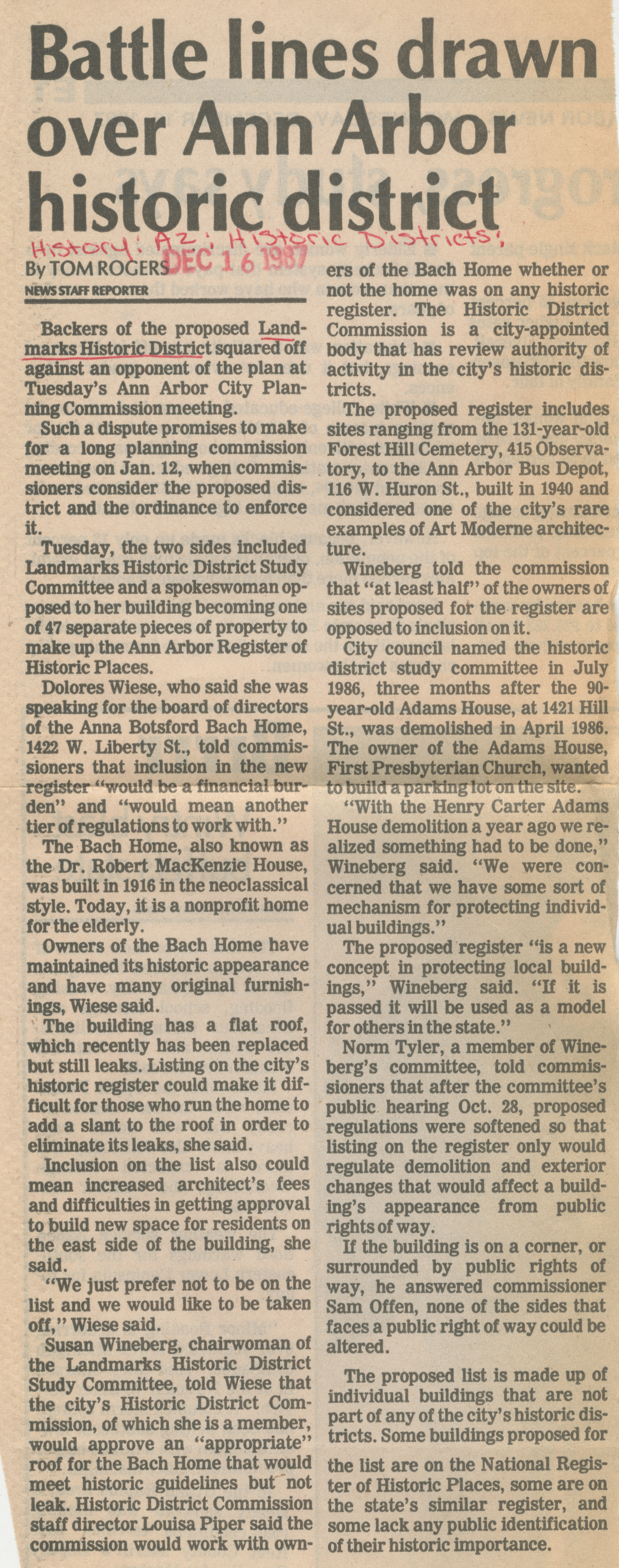Battle lines drawn over Ann Arbor historic district

Battle lines drawn over Ann Arbor historic district
By TOM ROGERS
DEC 16 1987
NEWS STAFF REPORTER
Backers of the proposed Land-marks Historic District squared off against an opponent of the plan at Tuesday’s Ann Arbor City Planning Commission meeting.
Such a dispute promises to make for a long planning commission meeting on Jan. 12, when commissioners consider the proposed district and the ordinance to enforce it.
Tuesday, the two sides included Landmarks Historic District Study Committee and a spokeswoman opposed to her building becoming one of 47 separate pieces of property to make up the Ann Arbor Register of Historic Places.
Dolores Wiese, who said she was speaking for the board of directors of the Anna Botsford Bach Home, 1422 W. Liberty St., told commissioners that inclusion in the new register “would be a financial burden” and “would mean another tier of regulations to work with.”
The Bach Home, also known as the Dr. Robert MacKenzie House, was built in 1916 in the neoclassical style. Today, it is a nonprofit home for the elderly.
Owners of the Bach Home have maintained its historic appearance and have many original furnishings, Wiese said.
The building has a flat roof, which recently has been replaced but still leaks. Listing on the city’s historic register could make it difficult for those who run the home to add a slant to the roof in order to eliminate its leaks, she said.
Inclusion on the list also could mean increased architect’s fees and difficulties in getting approval to build new space for residents on the east side of the building, she said.
“We just prefer not to be on the list and we would like to be taken off,” Wiese said.
Susan Wineberg, chairwoman of the Landmarks Historic District Study Committee, told Wiese that the city’s Historic District Commission, of which she is a member, would approve an “appropriate” roof for the Bach Home that would meet historic guidelines but not leak. Historic District Commission staff director Louisa Piper said the commission would work with owners of the Bach Home whether or not the home was on any historic register. The Historic District Commission is a city-appointed body that has review authority of activity in the city’s historic districts.
The proposed register includes sites ranging from the 131-year-old Forest Hill Cemetery, 415 Observatory, to the Ann Arbor Bus Depot, 116 W. Huron St., built in 1940 and considered one of the city’s rare examples of Art Moderne architecture.
Wineberg told the commission that “at least half” of the owners of sites proposed for the register are opposed to inclusion on it.
City council named the historic district study committee in July 1986, three months after the 90-year-old Adams House, at 1421 Hill St., was demolished in April 1986. The owner of the Adams House, First Presbyterian Church, wanted to tauilda parkinglotoirthe'site.
“With the Henry Carter Adams House demolition a year ago we realized something had to be done,” Wineberg said. “We were concerned that we have some sort of mechanism for protecting individual buildings.”
The proposed register “is a new concept in protecting local buildings,” Wineberg said. “If it is passed it will be used as a model for others in the state.”
Norm Tyler, a member of Wine-berg’s committee, told commissioners that after the committee’s public hearing Oct. 28, proposed regulations were softened so that listing on the register only would regulate demolition and exterior changes that would affect a building’s appearance from public rights of way.
If the building is on a corner, or surrounded by public rights of way, he answered commissioner Sam Offen, none of the sides that faces a public right of way could be altered.
The proposed list is made up of individual buildings that are not part of any of the city’s historic districts. Some buildings proposed for
the list are on the National Register of Historic Places, some are on the state’s similar register, and some lack any public identification of their historic importance.
Article
Subjects
Tom Rogers
Landmarks Historic District
Ann Arbor City Planning Commission
Historic Districts
Historic Preservation
Landmarks Historic District Study Committee
Ann Arbor Register of Historic Places
Anna Botsford Bach Home
Ann Arbor Historic District Commission
Henry Carter Adams House
Old News
Ann Arbor News
Dolores Wiese
Susan Wineberg
Louisa Pieper
Norm Tyler
Sam Offen